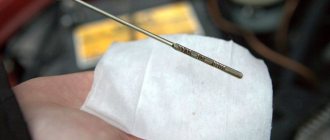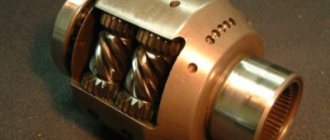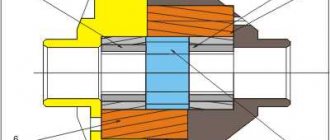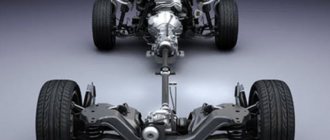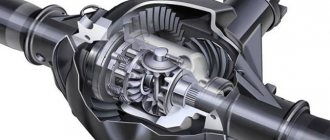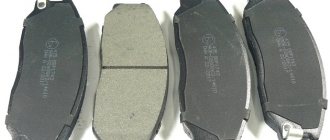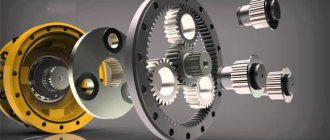The VAZ-2114 car is equipped with a modern injection internal combustion engine. The operation of the power unit is completely controlled by the ECU (electronic engine control unit or the “brains” of the machine). It is he who is responsible for the timely supply of fuel to the manifold, sparks to ignite the mixture, and he is responsible for the stable operation of the engine in all modes. Let's find out how the “brains” of the VAZ-2114 work, what types they are, where the ECU is located, what malfunctions the owner may encounter, and how to diagnose this device. This information will be useful for every car owner.
Description
The main device of the VAZ-2114 ECU is a microprocessor. Its main task is to fully control all engine systems when starting it and during operation in different modes and under different loads.
The electronic system, using a certain algorithm, collects all the data from the sensors into a single whole and then processes it. The “brains” of the VAZ-2114 work with this data in order to give an adequate response to any changes in the vehicle systems, and then adjust the operation of all systems to the standard established by the manufacturer.
The electronic control unit also controls the actuators in the vehicle. This is a ventilation, power supply, ignition, diagnostics, and idle system.
Troubleshooting
To read errors in the ECU, you need a special diagnostic scanner; without it, it is impossible to find out why, for example, the “Check” is on. After errors are found, they are deciphered, followed by diagnostics or repair of a specific unit. Simply “clearing” errors is not correct, this is an error, since this will only clear the ECU memory, but will in no way solve the problem.
ECU malfunctions and causes of failure
It is not immediately possible to understand that the control unit is not working correctly; it manifests itself in different ways, these could be malfunctions in the operation of some engine systems, or problems with diagnosing the ECU itself. There may be illogical, chaotic appearances, as well as disappearances of errors and problems with the engine and the car as a whole. Simply put, “glitches”, they can be noticed by an experienced specialist.
ECU memory structure
The “brains” of the VAZ-2114 are characterized by a three-stage memory system. Each cascade is distinguished by the presence of separate working modules. Let's look at them in detail:
- RAM cascade is a familiar word for those who understand the design and operating principle of a PC. The functions of RAM (random access memory) in this case are also nothing new. The above cascade is a block of ordinary RAM where current work sessions are processed.
- The PROM block (programmable read-only memory) is a long-term memory in the VAZ-2114 ECU. The system contains data about when the driver needs to undergo maintenance. Fuel maps, previous calibrations, and control algorithms are also stored here. Also, in this block of “brains” of the VAZ-2114, the main firmware is saved. The information contained in this cascade will never be erased. If we draw an analogy with a computer, it is a device for permanently storing data; it will never be removed from here. When re-flashing the “brains”, changes are made here.
- The next stage is EPROM (electrically reprogrammable memory). This is a separate module. Its main function is to monitor the operation of anti-theft systems. The section stores encodings, passwords, methods and features of synchronizing information between the EEPROM and the immobilizer in the car. If suddenly for some reason the data packets do not match, the car engine will not start.
Each module is a separate block. The connections between them are made in the same way as on the computer motherboard.
What to do if the scanner does not see the VAZ 2114 ECU
Reader question: Guys, why does it say during diagnostics that there is no connection with the ECU? What to do? What to fix?
So, why doesn’t the scanner see the VAZ 2114 ECU? What should I do so that the device can connect and see the block? Today you can find many different adapters for testing a vehicle on sale.
If you buy an ELM327 Bluetooth, most likely you are trying to connect a low-quality device. Or rather, you could have purchased an adapter with an outdated version of the software.
Car diagnostics using a scanner
So, for what reasons does the device refuse to connect to the block:
- The adapter itself is of poor quality. Problems can be with both the device’s firmware and its hardware. If the main microcircuit is inoperative, it will be impossible to diagnose the engine operation, as well as connect to the computer.
- Bad connection cable. The cable may be broken or inoperative itself.
- The wrong version of the software is installed on the device, as a result of which it will not be possible to achieve synchronization (the author of the video about testing the device is Rus Radarov).
In this case, if you are the owner of a device with the correct firmware version 1.5, where all six of the six protocols are present, but the adapter does not connect to the ECU, there is a way out. You can connect to the unit using initialization strings, which allow the device to adapt to the commands of the machine’s motor control unit. In particular, we are talking about initialization lines for diagnostic utilities HobDrive and Torque for vehicles that use non-standard connection protocols.
Where is the control unit located?
According to the design features of the car, the “brains” of the VAZ-2114 are located under the dashboard. To dismantle the electronic unit for repair or flashing, you must first disassemble the tunnel. This can be done by unscrewing several screws on the passenger seat side. From there it is very convenient to pick up the plastic panel itself. When dismantling is completed, you will see a hole through which you can easily reach the ECU. It is secured with a metal clip.
Next, to completely dismantle the device, you need to grasp the latch and support the control unit. After this, unscrew the bolt and carefully pull out the control unit housing. You should turn off the power to the vehicle's on-board network in advance.
Short circuits are the enemy of any electronic device. But this car is a special case. When dismantling, you need to remove not only the ground, but also the positive terminal. The ECU is expensive and is very sensitive to short circuits.
You need to be prepared for the fact that on a used car, sometimes the ECU may be missing in its normal location. Where are the “brains” of the VAZ-2114 if they are not in the right place? The owner will have to look for this block.
Among the reasons are:
- Mechanical damage (cracks, impacts, etc.);
- Exposure to moisture (“drowned people”, as well as cases where the car was stored improperly);
- Outside interference (reprogramming, incorrect firmware, etc.);
- Overheating or hypothermia;
- Voltage drops in the on-board network, as well as a short circuit (due to incorrect connection of the battery terminals, as well as attempts to “light” and other violations of the rules for operating the on-board network);
- Corrosion or oxidation of some areas of the board or other important elements of the ECU.
Types of ECU
VAZ-2114 is a car that is already quite old. But time was not in vain for the model. Engineers and electronics specialists constantly worked to improve their brainchild. This also applies to the control unit. A total of eight generations of ECUs were produced. They differed not only in their technical characteristics, but also in their manufacturer.
The owner may be wondering what kind of “brains” are on the VAZ-2114. To find out, just visually look at the block body. There is a marking on it. It contains the ECU model number. It is enough to compare what is written on the block with the factory tables. Then it will become clear what is installed in the car.
Bosch M1.5.4, “Itelma 5.1”, “January 5.1”
If the car has Bosch firmware installed, then the following symbols can be seen on the body - 21114-1411020. If the numbers are 2114-1411020-70, 71, then this is Itelma. If the last digit is 72, then it is "January 5.1". These are second-generation units, representing more universal solutions that are found on the VAZ-2113 and 2115.
As for the principle of functioning of the “brains” of the VAZ-2114 with 8 valves, the ECU is completely identical. These units were installed on cars even after 2013, as the device turned out to be very successful. After 2013, the January 5.1 modification began to be produced in three versions. The main differences were in injection control. ECUs from Itelma and January 5.1 can be purchased today at prices starting from eight thousand rubles. Bosch ECUs were installed mainly on export cars, but they are offered at about the same price.
What kind of ECUs are installed on VAZ
The first cars of the domestic automobile industry were quite ordinary and completely mechanized. However, with the development of technology, VAZ also had to change something.
In particular, over time, control of the engine operation fell on the shoulders of the ECM. All injection engines were equipped with them, and with the release of new, more modern models, the presence of an engine control unit (for example, on the VAZ Priora or Kalina) was not even discussed. What evolution have these devices undergone? Let's get a look.
GM control units
These systems were installed on the first Samara models produced before 2000. They could be supplemented with a resonant knock sensor or not have it.
BOSCH engine control unit
Among the Bosch brand engine control units that were installed on VAZ group cars, it is worth highlighting:
- “Bosch M1.5.4, with simultaneous, pair-time or phased injection, which can be interchangeable with “VS 5.1”, “January 5.1.x”;
- "Bosch MP7.0" is mainly installed in a single volume and can work on other systems. Has a 55-pin connector.
- "Bosch M7.9.7", which began to be part of the VAZ group vehicles in 2003. Cars on which Bosch ECUs of this model were installed had to comply with Euro-2 and Euro-3 toxicity standards. The ECM itself is relatively light weight and smaller in size. In addition, it is equipped with a reliable connector and switch.
Control units "January"
As for the electronic engine control units “January”, in this case, too, several of the most well-known VAZ components can be identified. These include:
“January-4”, which, like GM-09, was installed on the first Samara models until the 2000s.
"January 5.1". All types of controllers of this type are built on the same platform, and the only differences are in the switching of injectors and the DC heater. The first version has phased injection and an oxygen sensor, while the second has parallel injection. The difference between these ECUs is only in the firmware, which means they can be interchanged.
Bosch M 7.9.7 and "January 7.2"
“January” was installed in a large number of models, depending on the engine size and type of equipment. For example, on a 1.5-liter eight-valve engine, ECUs from Avtel were installed, with 81 and 81 hour markings. The same “brains”, but from Itelma, were marked with 82 and 82 hour markings. "Bosch" was installed on export cars. The marking of such ECUs is as follows: 80 and 802 for EURO-2 and 30 for EURO-3 standard.
The 30th series of Bosch ECUs were also installed on 1.6-liter power units. Since the software was initially developed for volume 1.5, significant failures were observed or the system completely failed. Therefore, later they released a special package marked 31h.
Cars with a 1.6 engine manufactured for the domestic market were equipped with blocks from Avtel and Itelma. The first series from Avtel were marked 31. It was characterized by the same errors as the Bosch 30th series. Later the defects were eliminated in version 31h. Due to problems among competitors, car owners preferred blocks from Itelma. The successful series was released under the label 32.
The cost of a new block from these generations is now approximately eight thousand rubles. If you need a used unit, you can find it on the car market for up to four thousand rubles.
Methods for diagnosing the electronic unit
Since the car is domestic, various breakdowns and malfunctions are quite common. If the “check” lights up, then you cannot do without the use of special diagnostic devices. Even if there is a device, diagnostics will take time.
Most of all, owners praise the ELM-327 device. It is easy to use and will allow you to erase errors from the ECU memory, as well as flash the “brains” of the VAZ-2114. Most car owners immediately remove it if it is present. But this is the wrong approach. There is not a single error that just happens.
If you remove them, the car will not be completely functional. In addition, removing symptoms can lead to more dire consequences. But it also happens that the ECU does not respond to requests from diagnostic equipment at all and produces an error that cannot be found. In this case, inspect the housing for damage, then check the fuse and the unit for overheating. In case of serious mechanical damage and deformation, the electronic device must be replaced.

